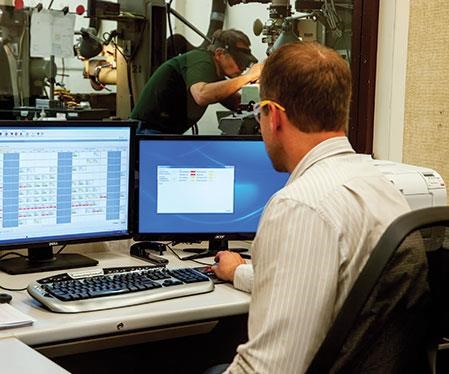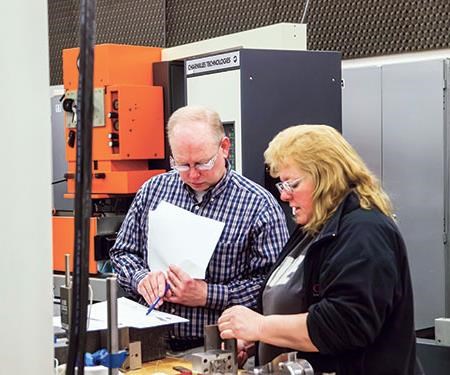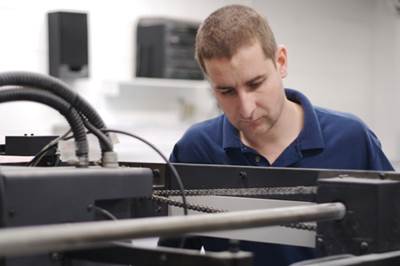Five Ways to Efficiently Tackle Shop Floor Management
Even the smallest mold shop can afford an integrated shop floor management system that allows for the management of every business transaction—from quote to cash—and is an invaluable tool for ensuring efficiency.
Owning and managing a mold shop may never have been particularly easy, but the current manufacturing environment in the U.S. makes it extremely challenging. Mold shops continue to face a unique set of challenges that may even be causing some shop owners to question whether they can remain in business, much less thrive.
Since the early 2000s, North American manufacturing has taken a huge hit as more and more manufacturing moved offshore. Mold and told & die shops were one of the first affected by this offshoring trend and while some of the work has returned, it is likely that business will never be the same. This offshoring caused many shops to experience double digit decline in revenues and profits, if it did not put them out of business completely. The Great Recession of 2009 only worsened the situation. The combination of these events resulted in a loss of more than 5 million manufacturing jobs in the U.S. from May 1999 through May 2009.
As challenging as the situation may have been and continues to be, it is possible to survive, and even thrive, in today’s economic environment. However, for many shop owners, it has required a shift in thinking. No longer is it enough to be a good toolmaker—owners must become savvy businesspeople as well. To succeed in today’s manufacturing climate, shop owners have to run their businesses like a business. This means thinking strategically and moving beyond the tactical thinking—getting out of the “firefighting mode.”
To continue to be world-class manufacturing companies, moldmakers especially must strive to avoid common mistakes made by many shops. Here you can learn how one mold shop in Minnesota learned the keys to running a successful business.
Custom Mold & Design (New Hope, MN) is entering its fifth decade of business, and is an example of how avoiding the common mistakes of many shops pays huge dividends. This shop has a proven track record of manufacturing more than 5,000 molds since the company was founded in 1965, and these molds have run tens of millions of cycles. In addition, their engineering and manufacturing staff has a combined experience of more than 1,000 years in manufacturing high quality molds. For this shop, it’s all about pursuing innovation and excellence in everything that they do. Following are five tips to get your shop moving in this direction.
1. Understand the Real Cost of Doing Business
Many mold shops assume they know how much it costs to manufacture a tool or mold, but this is often not the case. Simply looking at an income statement at the end of the month to measure the success of the business is not enough. Shops need to know all the specifics of the work that earned them money, and the work that didn’t. Owners and managers can only do this by understanding the true cost per hour by individual department or work center, and appropriately costing the work that goes through those areas of their shops.
Generating a truly accurate picture of all the variables that go into the true cost of a part or job can be difficult and time consuming without discipline and the right systems and technology. Consider all the factors that must be calculated to see the true cost of a job:
• Labor costed to the job based on the actual employee hourly rate
• Labor overhead (fringe benefits, vacation, other employer paid benefits and taxes) applied to the job based on direct labor hours
• Manufacturing overhead applied (by work center) based on the cost of running machines in that work center
• Selling, General, and Administrative overhead (all the other costs of doing business) applied proportionally to each job, either based on direct labor hour or another appropriate allocation method
• Material and outside service costs such as heat treating, plating, anodizing, etc. applied to the job based on actual cost (rather than standard or average) to correctly analyze the effect of the rising cost of material or the actual cost of the service performed
For Ray Newkirk, President of Custom Mold & Design, the importance of knowing the true cost of doing business started when he was 14 years old and was showing cattle for 4-H. “You need to know all the costs that go into raising cattle, and I applied this principle when I started the shop in 1965.” At first, Newkirk created a manual system so he could track what he was doing. This manual approach has given him appreciation of the importance of automating the process today.
He now understands and has tremendous discipline in tracking costs. For a shop owner to ensure this type of accuracy and efficiency, only automating the collection of this data allows for regular analysis of these costs and the ability to see what types of work truly are profitable.
There is incredible value in understanding true job cost. With this understanding, shop owners can easily eliminate jobs that consistently lose them money. If eliminating those jobs is not an option, shop owners will still at least understand the opportunity cost of running these unprofitable jobs.
2. Acknowledge the Customer Component
Good customers are the lifeblood of a business. Relationships with customers become even more important during a weak economy. However, when the economy is doing well, sometimes business owners become complacent towards their customers, and miss out on important opportunities to form quality relationships.
It is not enough to assume that no complaints from a customer mean the customer is happy. Good customer relations require that shops be proactive, contact their customers frequently to understand what is happening in their business.
Regular contact will allow shop owners to gain information that is key to managing their business such as:
• Is the customer experiencing any significant business issues?
• Is there an opportunity to gain more business or a new project?
• Is the customer planning on downsizing or expanding their supply chain?
• Does the customer have a preferred supplier program that can be leveraged?
Customer relationships can also be improved by increasing the information available about them and the information that can be shared with them. With the right systems and technology to support and manage customer relationships shops can “systemize the routine” so that they can “humanize the exception”.
Newkirk is passionate about instilling a customer service mentality at Custom Mold & Design. “We have a philosophy that starts and ends with people all working together and dedicated to providing each customer with the level of service and a quality product they demand. Our people use state of the art systems and procedures that provide results superior to our competition.” For Custom Mold & Design, keeping track of every customer interaction is critical to their business. It allows them to address issues as quickly as possible, before they even escalate to problems.
With the right systems, technologies and people in place to manage current customers, shops can then focus their efforts in driving new business. Specifically, systems and technology can help a shop recover the time lost due to inefficiency or duplicate data entry, so they can devote that time to exploring new market opportunities and new industries that are experiencing growth.
3. Recognize that Quality Is Not a Differentiator
It is not uncommon for most small and mid-sized shop owners to believe that quality is what sets them apart—that it is their key differentiator. Unfortunately, today quality is no longer a differentiator—it is an expectation.
Most shops have implemented quality management systems to monitor quality, including non-conformances and corrective actions. To stay competitive, it is an expectation that the shop has a formal quality management system in place that is integrated with their shop floor management solution.
Newkirk recognized early on that quality was becoming an expectation. He implemented a quality program at Custom Design and became ISO9001 and AS9100 certified. He did this because he saw it as a way to build the company culture he wanted to build, not because it was required. In the end it defined the way he wanted to do business and interact with his employees and his customers.
4. Value the Company’s Greatest Assets
Highly skilled and qualified shop employees have become hard to find and even harder to keep. The current shortage of skilled machinists and toolmakers is evidence of this. The gap between the skills required for a toolmaker today and the available pool of skilled workers continues to widen. This reality demonstrates how important it is for shop owners to become involved in their community to find future employees, and to invest and develop the employees they do have from within the company.
These goals can be accomplished in a variety of ways, including:
• Developing apprenticeship programs within the company, thus improving the skills of the employees you do have and keeping them engaged in the business;
• Working in cooperation with local technical colleges and universities, including developing appropriate school-work programs;
• Participating in mentoring or internship programs; and,
• Regularly visiting local high school vocational departments or technical schools and participating on their available boards.
To maintain an engaged workforce, it is important to participate in regularly scheduled employee reviews. This allows managers to understand their employees from direct and personal communication, including understanding their future goals and aspirations. This dialog can also facilitate ways to understand any issue they may be having with their jobs. Regular reviews also provide management the opportunity to develop and deploy individual employee training plans, so they can keep the best of the best.
Custom Mold & Design has taken on the challenge of attracting and retaining the most skilled employees to heart. For many years, Newkirk has served on the board of Dunwoody College of Technology in Minneapolis. He has also developed a program at Custom Mold & Design where students that have enrolled and registered at Dunwoody are offered a position with the company to put their knowledge and skills to work in a position directly related to their coursework.
Custom Mold & Design also diligently strives to create the best working environment and purchase the best equipment they can afford to help retain their employees. According to Newkirk, “You don’t get a second chance to make a first impression—whether it’s a new customer or a new employee who walks in the door.”
5. Manage with a Single Business Solution
There is no longer any excuse for relying on outdated shop floor management systems. Even the smallest mold shop today can afford an integrated shop floor management system. Such a system allows for the management of every business transaction, from quote to cash, and is an invaluable tool for ensuring efficiency.
Relying only on accounting systems and spreadsheets, with no connection to what is actually going on out on the floor, is a recipe for disaster. When such systems are not integrated, the data lacks the timeliness required to make important business decisions, shops cannot operate efficiently and it slows the business down leaving it to trail behind the competition.
A disjointed system only allows for so much growth before it actually starts to hinder growth. With an integrated shop floor management system, a shop can integrate all business information from quote to cash; avoid hiring additional staff to manage an unruly and disjointed system; allow current staff to become more efficient so they can focus on the business issues most important to running the shop; and, provide timely information required to accurately analyze the business and make decisions accordingly.
Several scalable business solutions are available even if a shop is very small. Being scalable, the systems should be able to grow with the business. Today the solutions are often bundled with an existing accounting solution or integrated seamlessly with common accounting solutions. For more than a decade, Custom Mold & Design has managed their entire business with a single manufacturing software solution.
The benefits of this single solution are primarily two-fold, according to Newkirk:
(1) Information is more accurate and timely and can be used to make critical decisions.
Specifically, estimators can review the job for a like tool that was built several years ago to produce a much more accurate quote today.
(2) Using a visual scheduling board, they have a clearer picture of bottlenecks and can make better commitments on delivery time to customers.
Summary
Running a successful small or mid-sized business will never be easy. Mold shops will continue to face challenges ranging from the economy to attracting and retaining the right employees to foreign competition. However, mold shops such as Custom Mold & Design will continue to stand out with their unique ability to embrace the right combination of management with a vision, utilization of the right technology and systems to get the job done, and their unrelenting passion to pursue excellence in everything they do.
For More Information
Custom Mold & Design
(763) 535-2334
sales@custommold.net
custommold.net
Related Content
MMT Chats: The Connection Between Additive Manufacturing Education and ROI
This MMT Chat continues the conversation with Action Mold and Machining, as two members of the Additive Manufacturing team dig a little deeper into AM education, AM’s return on investment and the facility and equipment requirements to implement AM properly.
Read MoreMMT Chats: Eliminating the Noise to Stay Focused on the Customer
Metro Mold & Design joins me to discuss the value of the 80/20 rule as a business strategy, its talented cross-functional team, the role of automation in mold building and molding, and the continuing impact of COVID-19.
Read MoreConfronting the Mold Design Talent Drought
Recently, I reposted on LinkedIn the results of an informal survey we conducted, which revealed a shortage of skilled mold designers. It quickly gained a lot of traction. Given the response, I thought I'd summarize the feedback and keep the conversation going.
Read MoreMachine Hammer Peening Automates Mold Polishing
A polishing automation solution eliminates hand work, accelerates milling operations and controls surface geometries.
Read MoreRead Next
Prepare for a New Economy with Three Critical Investments
It’s time for mold manufacturers to use the experience they’ve gained as craftsmen to develop new opportunities for their businesses.
Read MoreReasons to Use Fiber Lasers for Mold Cleaning
Fiber lasers offer a simplicity, speed, control and portability, minimizing mold cleaning risks.
Read MoreHow to Use Strategic Planning Tools, Data to Manage the Human Side of Business
Q&A with Marion Wells, MMT EAB member and founder of Human Asset Management.
Read More











.jpg;maxWidth=300;quality=90)













